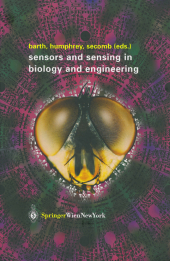 Neuerscheinungen 2012Stand: 2020-01-07 |
Schnellsuche
ISBN/Stichwort/Autor
|
Herderstraße 10
10625 Berlin
Tel.: 030 315 714 16
Fax 030 315 714 14
info@buchspektrum.de |

Friedrich G. Barth, Joseph A.C. Humphrey, Timothy W. Secomb
(Beteiligte)
Sensors and Sensing in Biology and Engineering
Herausgegeben von Barth, Friedrich G.; Humphrey, Joseph A.C.; Secomb, Timothy W.
Softcover reprint of the original 1st ed. 2003. 2012. xii, 404 S. XII, 404 p. 235 mm
Verlag/Jahr: SPRINGER, WIEN; SPRINGER, BERLIN 2012
ISBN: 3-7091-7287-X (370917287X)
Neue ISBN: 978-3-7091-7287-2 (9783709172872)
Preis und Lieferzeit: Bitte klicken
Biological sensors are usually remarkably small, sensitive and efficient. It is highly desirable to design corresponding artificial sensors for scientific, industrial and commercial purposes. This book is designed to fill an urgent need for interdisciplinary exchange between biologists studying sensors in the natural world and engineers and physical scientists developing artificial sensors. The main topics cover mechanical sensors, e.g. waves and sounds, visual sensors and vision and chemosensors. Readers will obtain a fuller understanding of the nature and performance of natural sensors as well as enhanced appreciation for the current status and the potential applicability of artificial microsensors.
INTRODUCTORY REMARKS Sensors and sensing: a biologist´s view (F. G. Barth), Sensors and sensing: an engineer´s view (H. Meixner) MECHANICAL SENSORS Waves, Sound and Vibrations How nature designs ears (A. Michelsen), How to build a microphone (P. Rasmussen), The middle and external ears of terrestrial vertebrates as mechanical and acoustic transducers (J. J Rosowski), The outer hair cell: a mechanoelectrical and electromechanical sensor/actuator (K.V. Snyder, F. Sachs, W. E. Brownell), The silicon cochlea (R. Sarpeshkar), Biologically-inspired microfabricated force and position mechano-sensors (P. Dario et al.) Force and Motion The physics of arthropod medium-flow sensitive hairs: biological models for artificial sensors (J. A. C. Humphrey, F. G. Barth, M. Reed, A. Spak), Cricket wind receptors: thermal noise for the highest sensitivity known (T. Shimozawa, J. Murakami, T. Kumagai), Arthropod cuticular hairs: tactile sensors and the refinement of stimulus transformation (F. G. Barth, H.-E. Dechant), The fish lateral line: how to detect hydrodynamic stimuli (J. Mogdans, J. Engelmann, W. Hanke, S. Kröther), The blood vasculature as an adaptive system: role of mechanical sensing (T. W. Secomb, A. R. Pries), Mechanism of shear stress-induced coronary microvascular dilation (L. Kuo, T. W. Hein), A possible mechanism for sensing crop canopy ventilation (T. Farquhar, J. Zhou, H. W. Haslach Jr.) VISUAL SENSORS AND VISION From fly vision to robot vision: re-construction as a mode of discovery (N. Franceschini), Locust s looming detectors for robot sensors (F. C. Rind, R. D. Santer, J. M. Blanchard, P. F. M. J. Verschure), Retina-like sensors: motivations, technology and applications (G. Sandini, G. Metta), Computing in cortical columns: information processing in visual cortex (S. W. Zucker), Vision by graph pyramids (W.G. Kropatsch) CHEMOSENSORS AND CHEMOSENSING Mechanisms for gradient following (D.B. Dusenbery), Representation of odor information in theolfactory system: from biology to an artificial nose (J. S. Kauer, J. White), The external aerodynamics of canine olfaction (G. S. Settles, D.A. Kester, L.J. Dodson-Dreibelbis), Microcantilevers for physical, chemical, and biological sensing (T. Thundat, A. Majumdar) THE EMBEDDING OF SENSORS Embedded mechanical sensors in artificial and biological systems (P. Calvert), Active dressware: wearable kinesthetic systems (D. de Rossi, F. Lorussi, A. Mazzoldi, P. Orsini, E. P. Scilingo)
Professor Friedrich G. Barth was born in Munich, Germany, in 1940. He studied biology and human physiology in Munich and Los Angeles. In 1967, he obtained his doctorate under H. Autrum, 1970 he received his Habilitation in zoology. In 1974, he was offered a chair at the University of Frankfurt/M. Since 1987, he has been professor at the University of Vienna, Austria. His main areas of research are neurobiology, sensory systems, and biomechanics. He is a member of several scientific academies and editor-in-chief of the Journal of Comparative Physiology A.


